PAHCS completes its building project
PAHCS will host an open house - from 4 to 8 p.m. - and offer tours - starting at the new emergency entrance - to show the public the improvements made to the facility during the recent $8.2-million building project that took two years to complete.
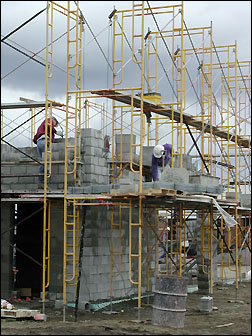 The project included four additions: a new emergency wing on the west side of the hospital; a new dining room for the Koronis Manor; new offices at the Paynesville Area Medical Clinic; and new meeting rooms and maintenance and storage areas. Extensive interior remodeling included the creation of three new birthing suites; the addition of a second, larger operating room; an expanded outreach (or specialty) clinic; a new front desk at the clinic entrance to provide more privacy; and a host of improvements at the Koronis Manor.
The project included four additions: a new emergency wing on the west side of the hospital; a new dining room for the Koronis Manor; new offices at the Paynesville Area Medical Clinic; and new meeting rooms and maintenance and storage areas. Extensive interior remodeling included the creation of three new birthing suites; the addition of a second, larger operating room; an expanded outreach (or specialty) clinic; a new front desk at the clinic entrance to provide more privacy; and a host of improvements at the Koronis Manor.
Ground was broken on the project in May 2001, and the work was expected to take 16 months. But the original plumbing contractor declared bankruptcy within a couple months, causing a delay of a month, and ventilation work at the Koronis Manor proved more complex than anticipated, and the project ended up lasting two years. Ventilation work in the Koronis Manor was expected to take two or three days per room but residents were actually out of their rooms for up to eight weeks.
Patients, families, and staff need to be commended for their patience, understanding, and extra work throughout the construction and remodeling, said Bev Mueller, acute care administrator for PAHCS, who oversaw the project.
As a health care facility, PAHCS had to continue to operate while construction was being done, making the project, and its timing, especially complex.
A big reason why PAHCS was always in operation was the flexibility of the contractors, said Mueller. It would have been impossible to continue to operate the facility without the willingness of contractors to perform the work at an optimum time for PAHCS. "The contractors were very good to work with us," said Mueller.
The project cost also increased due to its complexity. Originally budgeted at $7.4 million, the final project cost is $8.2 million, mainly due to extra costs in the Koronis Manor, additional mechanical work, and new equipment in the operating room. See map of the campus.
A city-owned hospital was built in Paynesville in 1956, and a nursing home - the Koronis Manor - was added in 1964. No major improvements were made to the facility until 1983, when the hospital pods were added, the lab and x-ray departments were updated, and an outreach clinic was started. In 1987, 700 Stearns Place - apartments for independent senior living - was added, and in 1995 a clinic was added to the facility.
The recently-completed remodeling project included the first major renovations in the Koronis Manor since it was built and the second major renovation of the hospital.
Emergency Wing
 One of the first additions in this building project, a new emergency wing was added to the west side of the hospital. The new emergency wing contains three procedure/trauma rooms, an exam room, and a new ambulance entrance.
One of the first additions in this building project, a new emergency wing was added to the west side of the hospital. The new emergency wing contains three procedure/trauma rooms, an exam room, and a new ambulance entrance.
On a recent weekday morning, five emergency cases came to PAHCS within a 90-minute span, starting at 7 a.m.
That much activity would have swamped the old emergency room, as well as disrupt the outreach department, said Mueller. Before the new emergency wing was added, PAHCS had one large emergency room with a curtain to separate patients. PAHCS used to share exam rooms and a procedure room between the emergency room and the outreach clinic, meaning that lots of emergency activity would also disrupt patients coming to see specialists.
If five emergency cases had come to PAHCS before the new emergency wing opened in the fall of 2001, "Somebody would have had to wait," said Mueller.
The new wing was able to handle all those emergency patients without disrupting outreach.
As PAHCS has grown - forming a partnership with a physician group and adding five clinics in the past decade - its larger patient base has meant more activity in its emergency room. Patients who see a physician from the Paynesville Medical Group at a PAHCS clinic naturally come to the local hospital for emergency care, said Mueller.
PAHCS now sees at least 150 patients each month in its emergency room, more in the summer, said Mueller.
The new emergency entrance is located near the northwest corner of the hospital, with access from the PAHCS parking lot at the corner of First Street and Stearns Avenue.
The hospital nursing station - while remaining in the same location - was updated and revamped to face the new emergency entrance. The nurse's call system throughout the facility was upgraded during the remodeling.
Birthing Suites
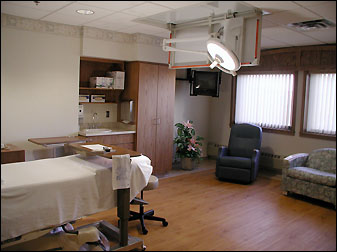 Three new birthing suites opened in November 2002. Actually, one had been completed much earlier in the project, but until all three were done it had to be used as a traditional labor room, meaning mothers could give birth in the room but then had to move to a traditional hospital room to clear the room for the next delivery.
Three new birthing suites opened in November 2002. Actually, one had been completed much earlier in the project, but until all three were done it had to be used as a traditional labor room, meaning mothers could give birth in the room but then had to move to a traditional hospital room to clear the room for the next delivery.
The birthing suites offer a new method for childbirth. They are designed to be comfortable, with a private bath and a pull-out couch for the father, while having all the necessary medical equipment for delivery. The equipment, though, can be stowed, making the room look more like a hotel room than like the labor and delivery rooms of the past.
At one time, mothers giving birth at PAHCS spent time in at least three rooms (the labor room, delivery room, and their hospital room) and needed to make at least two moves by cart, including one move when labor got so intense that they needed to go to the delivery room.
Now, mothers at PAHCS can unpack when they arrive and then labor, deliver, and recover in a birthing suite.
"This way you don't have to make any (moves)," said Mueller. "When you are in the last stages of labor, that's the last thing you want to think about, and after the birth you don't want to move either. You want to enjoy the baby."
One of the first mothers to use a birthing suite as intended found it to be relaxing to stay in one room, quiet to be away from hospital traffic, and appreciated that her husband could stay in the same room.
In 2002, PAHCS had 126 births. According to Mueller, that number ideally could increase, and PAHCS could easily add another birthing suite if needed.
Operating Room
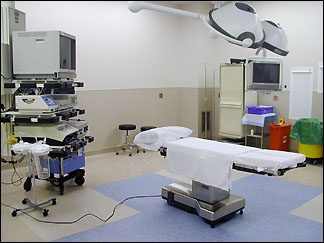 A new, larger operating room was added to the hospital with state-of-the-art equipment, including the orthopedic equipment necessary to do hip and knee replacement surgeries.
A new, larger operating room was added to the hospital with state-of-the-art equipment, including the orthopedic equipment necessary to do hip and knee replacement surgeries.
The first knee surgery at PAHCS was done last week.
In order to do orthopedic procedures at PAHCS took the cooperation of the surgeons, the rehabilitation department, the laboratory staff, the radiology staff, the hospital nurses, the physicians, the Pharm.D.s, and the purchasing department, said Mueller. "That is probably the neatest thing about our facility," she said. "The departments really work well together. When we want to start a new service, they all are willing to help," she explained.
PAHCS also added new monitors and better optics for laproscopic surgeries. Within the last year, PAHCS has also acquired a C-arm x-ray machine that can be used in the operating rooms in order to perform surgeries that need up-to-the-minute x-rays.
The new operating room should allow PAHCS the room to grow, said Mueller. They should have room to add new equipment, too. "With the size of the new room, we should (have the space to) add whatever we need," said Mueller.
The new operating room at PAHCS "is perhaps the largest we've ever worked in. It's got excellent equipment, and it's got excellent staff," said Dr. Alan Tims, one of four surgeons from Central Minnesota Surgeons who comes to PAHCS. "What more could you want? I think it's a great facility."
Tims, a colorectal and general surgeon, has been coming to PAHCS for 21 years. As well as operating a clinic and doing surgeries in St. Cloud, Tims and his partners provide outreach surgical services in Melrose, Mora, Paynesville, and Sauk Centre, with Mora and Paynesville being the busiest.
PAHCS has been blessed with great leadership, said Tims, and it has offered progressive services and gotten state-of-the-art equipment. According to Tims, PAHCS proves that "small size does not mean that you have to be behind the times." While Tims thinks PAHCS already offered quality care, the new additions improve the facility.
Outreach Clinic
The outreach department, or the specialty clinic, was enlarged significantly during the remodeling project, increasing its space by nearly half.
Previously outreach had six exam rooms and two procedure rooms for specialists coming to PAHCS on a weekly or monthly basis and for PAHCS's own medical staff. With the remodeling, outreach now has ten exam rooms and three procedure rooms plus a dedicated room for chemotherapy, a larger waiting room, and a reconfigured front desk to ensure privacy.
Since outreach department was in the middle of the building, landlocked so to speak, an addition for maintenance and material management (the supply department) and new meeting rooms was put on the north side of the facility, with those departments moving and outreach getting their old space.
Some specialists in outreach see 30 or 40 patients in a day, and their appointments may last longer than typical family physician visits (anywhere from 10 to 45 minutes), according to Mueller. The outreach clinic sees around 550 patients per month.
The physical size of the department was cramping PAHCS's ability to schedule these specialists. "Before we struggled to have three physicians, now we can have four specialists at one time," said Mueller.
PAHCS plans to arrange for the urologists and for the surgeons to come another day each week. The surgeons, for instance, come on Mondays to meet with patients and to do procedures like colonoscopies. On Wednesdays, all the surgeries are done in the operating room. If a surgeon comes for another day, they will be able to do more procedures in outreach and possibly more surgeries.
Mueller also wants to look for a rheumatologist but knows they are in high demand and may be difficult to find.
The outreach clinic also has a new sound booth and audio equipment for hearing tests, usually conducted by its ear, nose, and throat specialists.
Koronis Manor
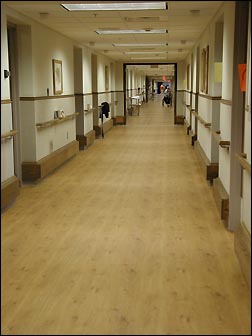 The first structural changes at the Koronis Manor - since it opened in 1964 - were extensive, and complicated to accomplish. Nearly $1.5 million was spent on upgrades at the Koronis Manor, according to Tom Kooiman, chief operating officer for PAHCS.
The first structural changes at the Koronis Manor - since it opened in 1964 - were extensive, and complicated to accomplish. Nearly $1.5 million was spent on upgrades at the Koronis Manor, according to Tom Kooiman, chief operating officer for PAHCS.
"Most of that money went into the mechanical portion," he explained. "What you don't see is all the work that went into the rooms so they can control their own heat."
Because the facility had one central heating and cooling mechanism, it was difficult to maintain optimum temperatures in all wings simultaneously. In the Koronis Manor, that meant it got too hot in the summer and too cold in the winter. Now, due to the mechanical and ventilation improvements, each room in the Koronis Manor will be able to control their temperature individually. Each wing will be able to do likewise.
Doing the ventilation and mechanical work at the nursing home was much more complicated than expected. Doing the work in each room was expected to take two or three days, but residents were temporarily displaced for up to eight weeks, much longer than anticipated, said Mueller.
One required improvement in the Koronis Manor was the addition of a sprinkler system. These have been required by code for a long time, but PAHCS had been exempted until it did structural remodeling.
Asbestos on piping in the Koronis Manor also was abated during this project, believed to be the last asbestos in the facility.
Other improvements at the Koronis Manor were for space. When the nursing home was built in 1964, only one quarter of the residents were in wheelchairs. Now 90 percent of the residents use wheelchairs, as more health care options now exist. This increase in the wheelchair population at the Koronis Manor meant floor space in the bathrooms, in the tub room, and in the dining room was not ideal. These areas were expanded, and a second tub room was added, in order to offer baths more frequently. Before these additions, some residents had to eat in the lounge due to lack of dining space and residents had to start taking baths early in the morning in order to get all the residents washed using only one tub room.
Infrastructure improvements were also made during this construction project in order to add another wing to the Koronis Manor eventually. This new wing would enable the nursing home to switch to private rooms with private baths, but it was not included in this project. PAHCS has received an exemption from the state to do this addition but will have to wait until its finances permit it to afford this other addition.
The Paynesville Area Health Care Auxiliary donated a wandering system at the Koronis Manor - to keep patients that might wander in the building while allowing other residents complete freedom of movement - and the auxiliary donated TVs and VCRs in the birthing suites to do postnatal education.
Other Improvements
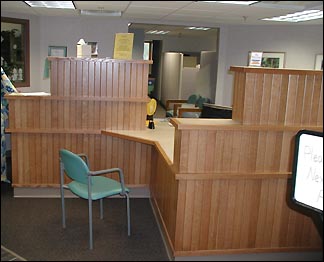 The building project included other improvements in various areas.
The building project included other improvements in various areas.
Carpeting in the hospital, for instance, was replaced. This carpeting had been damaged due to humidity problems in the hospital, which now should be corrected by the new heating, cooling, and ventilation system.
The front desk at the main clinic entrance was also improved, in part because federal law - HIPAA - requires greater privacy measures. The new front desk has separate stations: one for check-in for appointments and the other for making follow-up appointments. In order to make efficient use of the medical staff, scheduling requires some details in order to allot the needed time.
And cardiac rehab - the exercise equipment used by patients recovering from cardiac arrests and heart ailments - has been moved closer to the hospital. Cardiac rehab used to be located in the rehabilitation department. That department will use the vacated space for a new shoulder machine and to give more space to occupational therapy, which has added a kitchen in order to practice more life skills.
Still remaining to be completed is a little sidewalk repair, some work on the concrete floor in the ambulance garage, and other minor items. Mueller said she will be pleased when all the Ts are crossed and the project is totally done.
Contact the author at editor@paynesvillepress.com • Return to News Menu
Home | Marketplace | Community